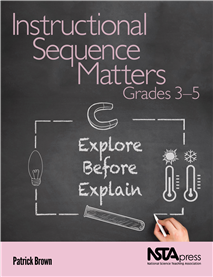NSTA Press
Explore Before Explain to Engage More Students
By Carole Hayward
Posted on 2020-02-23
A new addition to the Instructional Sequence Matters series has arrived! Instructional Sequence Matters, Grades 3-5 by Patrick Brown offers examples and strategies for using POE (Predict, Observe, and Explain) and 5E (Engage, Explore, Explain, Elaborate, and Evaluate) with students to tap into their innate curiosity and prepare them for deep learning.
Instructional Sequence Matters focuses on explore-before-explain teaching, which the author explains is a way of thinking “more purposefully and carefully about the nature of how we design instruction.”
Students come to the classroom as knowers already. They come with knowledge, ideas, experiences that have developed their understanding of how the world works. They come with a sense of curiosity, and questions, such as why do rainbows appear in the sky; why do leaves change colors; and why does the moon go through different phases, explains Brown. As they learn in school, they build on their previous experiences, correct errors in their thinking, revise misconceptions, and build new knowledge.
“I firmly believe that a significant task of science teaching is cultivating the innate skills that child scientists bring to school and balancing their ideas with purposeful pedagogical practices,” says Brown. “Bringing an explore-before-explain mindset to science teaching is a way to develop the budding scientist in each of your students.”
According to Brown, this instructional method has far-reaching implications in the elementary school classroom, beyond science instruction.
“[It] lends empirical support for the placement of other experiences in the elementary classroom to leverage the best possible learning experiences for students,” says Brown. “One of the hallmarks of explore-before-explain teaching is its emphasis on learning for understanding and wiring (or rewiring) the brain, so knowledge is deeply blanketed in evidence-based experiences.”
Brown’s objective is also to rewire how educators think about sequencing. Instructional Sequence Matters helps educators to understand the developmental psychology, neuroscience, cognitive science, and science education research that explains why the order in which lessons are structured is so critical.
The book provides examples that show how specific aspects of all three dimensions of the Next Generation Science Standards can translate into the classroom: 1) science and engineering practices, 2) disciplinary core ideas, and 3) crosscutting concepts. It includes detailed, ready-to-teach lessons that use either a POE or 5E sequence to cover a variety of science topics such as heat and temperature, magnetism, and electric currents.
Instructional Sequence Matters will help educators to promote long-lasting understanding by motivating their students, encouraging them to think critically, and engaging them more deeply with content.
Read the free chapter “Learning About Ecosystems.”
Disclaimer: The views expressed in this blog post are those of the author(s) and do not necessarily reflect the official position of the National Science Teaching Association (NSTA).


